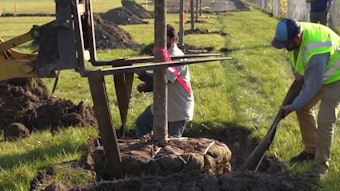
A little bit of lawn thatch is good, but too much can cause serious problems in a lawn.
“Thatch is the collection of organic material that collects on the soil surface of grass,” says Linda Beattie of Schiller Grounds Care, parent company of Classen. “Grass clippings, roots, weeds and other organic material naturally collects on the soil surface of the turf during the season’s most aggressive growth period—and overwhelms the natural decomposition process. Once the process is delayed for any number of reasons, thatch can quickly go from a nuisance to a serious problem. Thatch can actually choke a lawn to death.”
As it thickens, thatch robs the soil of air and hinders water absorption and nutrient penetration to the soil and root system. “Not only will excessive thatch kill the grass, if left undeterred long enough it will damage the soil so that even if removed, new growth in that area will be sparse at best,” Beattie cautions. “Thick thatch levels (over an inch) can also become a haven for insects. Moisture-rich, matted thatch can be an excellent breeding ground for mosquitoes and disease.”
Dethatching lifts damaging thatch from the soil surface—instantly exposing the soil and grass root system to air, water and nutrients.
Best time to dethach. Beattie says it depends on where you live, and if you have cool-season grass or warm-season grass. Generally speaking, you should dethatch in early fall before you fertilize, or in the spring after the grass has begun to green. “Either way, the grass should have a period to recuperate before the temperature changes and the grass goes into dormancy.”
How to sell. Landscape contractors who offer a dethatching service often offer it as part of an overall lawn care package which also includes fertilizing, pre- and post-emergent weed control, aerating and sometimes overseeding. However, many contractors also find success in selling dethatching services on an “as needed” basis.
Beattie explains, “Dethatching can be sold on an 'as needed' basis to protect the turf in prolonged adverse conditions or as part of a turf care maintenance package. Often turf care services are coupled together either as a part of an annual service or are needed to tackle a specific problem. With regards to thatch, quite often after dethatching, you may notice bare and thinning sports in the lawn. Thinning and bare spots are a visual indicator that the soil is compacted. To rectify the situation, the lawn will require aeration to reduce soil compaction and seeding or overseeding to replenish.”



























